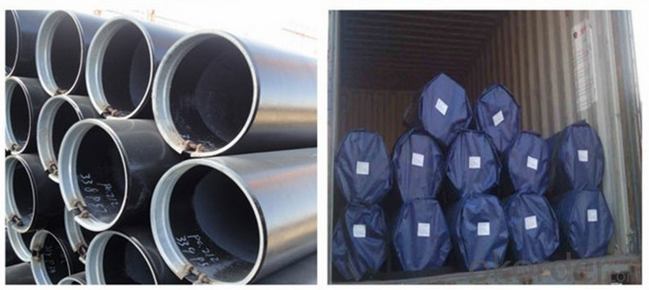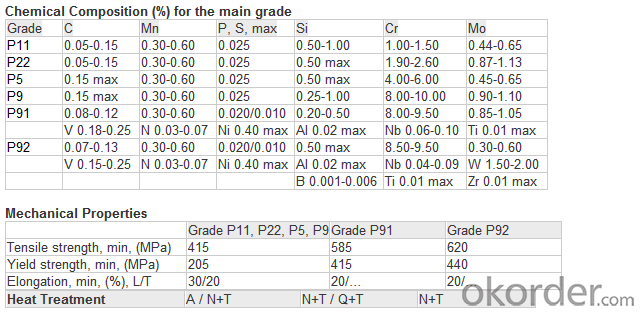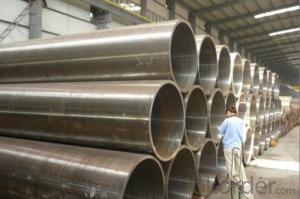SA335/SA335M Seamless Ferritic Alloy-Steel Pipe for High-Temperature Service
- Loading Port:
- Shanghai
- Payment Terms:
- TT OR LC
- Min Order Qty:
- 1000 kg
- Supply Capability:
- 10000 kg/month
OKorder Service Pledge
OKorder Financial Service
You Might Also Like
ASTM A335 Seamless Alloy-Steel Pipe
Standard: BS 1139, BS 3059-2, JIS G3454-2007
Grade: 10#-45#, 15NiCuMoNb5, 10Cr9Mo1VNb
Detailed introduction to ASTM A335 seamless alloy steel pipe:
ASTM A335 seamless alloy steel pipe


FAQ:
1) why you chose us ?
Professional Manufacturer and supplier of Steel pipe
More than 14 years’ professional producing experience
We can get the lowest ex-factory prices. The price are quite reasonable and it is lower than our commercial peers. also, we can guarantee the qualities of our products.
BV, ISO certificates and SGS test can be provided to assure the quality of our products.
2) Our minimum order quantity:
10 Metric Tons or one 20ft or 40ft Container.
3) How about the Delivery Time?
The steel pipe will be produced since we getting your deposit by T/T or Your original L/C. For normal size, some stocks in our factory now, we can supply once you need.
4)What kind of payment does your company support?
T/T, 100% L/C at sight, Cash, Western Union are all accepted.
5) Do you charge for the samples?
According to our company principle, we just charge for samples, you pay for the freight /courier charge.
6) Main market:
Mid East, South America, Africa, Southeast Asia, India etc
FAQ:
1) why you chose us ?
Professional Manufacturer and supplier of Steel pipe
More than 14 years’ professional producing experience
We can get the lowest ex-factory prices. The price are quite reasonable and it is lower than our commercial peers. also, we can guarantee the qualities of our products.
BV, ISO certificates and SGS test can be provided to assure the quality of our products.
2) Our minimum order quantity:
10 Metric Tons or one 20ft or 40ft Container.
3) How about the Delivery Time?
The steel pipe will be produced since we getting your deposit by T/T or Your original L/C. For normal size, some stocks in our factory now, we can supply once you need.
4)What kind of payment does your company support?
T/T, 100% L/C at sight, Cash, Western Union are all accepted.
5) Do you charge for the samples?
According to our company principle, we just charge for samples, you pay for the freight /courier charge.
6) Main market:
Mid East, South America, Africa, Southeast Asia, India etc
- Q:What is the difference between 2205 and 2507 stainless steel pipes?
- The main difference between 2205 and 2507 stainless steel pipes lies in their chemical composition and corrosion resistance properties. 2205 stainless steel is a duplex stainless steel that contains a balanced proportion of austenite and ferrite phases. It consists of about 22% chromium, 5% nickel, 3% molybdenum, and small amounts of nitrogen and other elements. This composition provides 2205 stainless steel with good strength, excellent corrosion resistance, and high resistance to stress corrosion cracking. On the other hand, 2507 stainless steel is a super duplex stainless steel that contains higher levels of chromium, nickel, molybdenum, and nitrogen compared to 2205. It typically comprises approximately 25% chromium, 7% nickel, 4% molybdenum, and 0.25% nitrogen, along with other alloying elements. These additions enhance the corrosion resistance, strength, and overall performance of 2507 stainless steel pipes, particularly in highly corrosive environments such as seawater, chemicals, and acidic solutions. In terms of corrosion resistance, 2507 stainless steel pipes offer superior resistance to pitting, crevice corrosion, and general corrosion compared to 2205 stainless steel. This makes 2507 stainless steel pipes highly suitable for applications where extreme corrosion resistance is required, such as offshore oil and gas platforms, chemical processing plants, and desalination plants. Overall, while both 2205 and 2507 stainless steel pipes are duplex stainless steels, the higher alloy content and enhanced corrosion resistance of 2507 stainless steel pipes make them more suitable for severe and corrosive environments. However, 2205 stainless steel pipes still offer excellent performance and can be a cost-effective alternative in less demanding applications.
- Q:What are the factors to consider when selecting stainless steel pipes for a specific application?
- When selecting stainless steel pipes for a specific application, several factors need to be considered to ensure the right choice is made. 1. Corrosion Resistance: Stainless steel is known for its exceptional resistance to corrosion, but different grades offer varying levels of protection against specific corrosive environments. The type of corrosive agents present in the application, such as chemicals, moisture, or high temperatures, should be carefully evaluated to select a stainless steel grade that can withstand them effectively. 2. Temperature and Pressure: Stainless steel pipes are used in a wide range of temperature and pressure conditions. The selected grade must have the necessary strength and resistance to handle the specific temperature and pressure levels required by the application. Higher temperatures may require grades with increased heat resistance, while high-pressure environments may benefit from pipes with higher tensile strength. 3. Material Compatibility: In some applications, stainless steel pipes may come into contact with other materials or substances, such as liquids or gases. It is crucial to consider the compatibility of the stainless steel with these materials to avoid any potential chemical reactions, contamination, or degradation. Compatibility testing or consulting with experts can help determine the best choice of material. 4. Size and Dimensions: The size and dimensions of the stainless steel pipes should match the requirements of the application. This includes considering the diameter, thickness, and length of the pipes. Proper sizing ensures optimal flow rates, structural integrity, and ease of installation. 5. Cost: Cost is always a factor to consider in any decision-making process. Different stainless steel grades vary in price, and it is essential to balance the desired properties with the available budget. While cost should not be the sole determining factor, it is important to find a stainless steel pipe that meets the required specifications without exceeding the allotted budget. 6. Standards and Certifications: Depending on the application, certain standards and certifications may be required, such as ASTM, ASME, or ISO. These standards ensure that the stainless steel pipes meet specific quality and performance criteria. It is crucial to select pipes that comply with the necessary standards and have appropriate certifications to ensure reliability and safety. 7. Maintenance and Durability: Consider the maintenance requirements and expected lifespan of the stainless steel pipes. Some applications may require regular cleaning, inspection, or maintenance, while others may need pipes with long-term durability and resistance to wear and tear. By carefully evaluating these factors, one can make an informed decision when selecting stainless steel pipes for a specific application, ensuring they meet the necessary performance, quality, and safety requirements.
- Q:Are stainless steel pipes suitable for gas distribution systems?
- Indeed, stainless steel pipes prove themselves to be appropriate for the distribution of gas. Due to its exceptional durability and resistance to corrosion, stainless steel emerges as an excellent choice for transporting gases. Its ability to endure high pressures and temperatures guarantees the safe and effective distribution of gas. Moreover, stainless steel pipes boast a lengthy lifespan, diminishing the necessity for frequent replacements and subsequently reducing maintenance expenses. All in all, stainless steel pipes offer a trustworthy and secure resolution for gas distribution systems.
- Q:How is stainless steel pipe manufactured?
- Stainless steel pipe is manufactured through a process called seamless or welded pipe manufacturing. In the seamless method, a solid cylindrical billet of stainless steel is heated and pierced to form a hollow tube. This tube is then elongated and rolled to the desired diameter and thickness. Welded stainless steel pipe, on the other hand, involves the joining of two or more stainless steel plates or coils through a welding process. The resulting pipe is then further processed and finished to meet specific industry standards and requirements.
- Q:What is the difference between seamless and hot-expanded stainless steel pipes?
- Two distinct methods exist for manufacturing stainless steel pipes: seamless and hot expansion. Seamless stainless steel pipes are formed by piercing a solid billet of stainless steel and rolling it into the desired pipe shape. In this process, there is no welding or joining of separate pieces, resulting in a seamless pipe. These pipes are renowned for their uniformity and strength, as they lack weak points or potential leak paths. Although more expensive to produce, they are essential in applications requiring high corrosion resistance and pressure handling, such as in the oil and gas industry or high-pressure boilers. Conversely, hot-expanded stainless steel pipes are created by heating a stainless steel pipe and expanding it to a larger diameter using a mandrel within the pipe. This method is employed to produce larger diameter pipes for specific purposes. The hot expansion process can enhance the mechanical properties of the pipe, including increased tensile strength and improved corrosion resistance. Industries such as petrochemical, power generation, and construction frequently employ these pipes. In conclusion, the key distinction between seamless and hot-expanded stainless steel pipes lies in their manufacturing processes and resulting properties. Seamless pipes are crafted by rolling a solid billet, while hot-expanded pipes are formed by heating and expanding an existing pipe. Seamless pipes are recognized for their strength and uniformity, while hot-expanded pipes are often utilized for larger diameter applications and can possess enhanced mechanical properties.
- Q:How do you remove scratches from stainless steel pipes?
- To remove scratches from stainless steel pipes, you can try the following methods: 1. Cleaning: Start by cleaning the surface of the pipe with a mild dish soap and warm water. Use a sponge or soft cloth to gently scrub the scratched area and remove any dirt or debris that might be present. 2. Baking soda paste: Make a paste by mixing baking soda with water until it forms a thick consistency. Apply the paste to the scratched area and gently rub it in circular motions using a soft cloth. Rinse off the paste with warm water and dry the surface with a clean towel. 3. Toothpaste: Apply a small amount of non-gel toothpaste to the scratched area. Using a soft cloth or sponge, rub the toothpaste in gentle circular motions. Rinse off the toothpaste with warm water and dry the surface thoroughly. 4. Stainless steel cleaner: Look for a cleaner specifically designed for stainless steel surfaces. Follow the instructions provided on the cleaner's packaging, as different products might have varying application methods. Use a soft cloth or sponge to apply the cleaner and gently rub the scratched area. Rinse off the cleaner with warm water and dry the surface completely. 5. Stainless steel scratch remover kit: If the scratches are deep or extensive, you might want to consider using a stainless steel scratch remover kit. These kits typically include abrasive pads and a polishing compound that can help to buff out scratches. Follow the instructions provided with the kit to achieve the best results. Remember to always test any cleaning or scratch removal method on a small, inconspicuous area of the stainless steel pipe before applying it to the entire surface. Additionally, it's important to avoid using abrasive materials or harsh chemicals that could further damage the stainless steel.
- Q:What is the working temperature range for stainless steel pipes?
- The working temperature range for stainless steel pipes typically ranges from -150°C (-238°F) to 816°C (1500°F).
- Q:How are stainless steel pipes insulated?
- To ensure thermal efficiency and prevent heat loss or condensation, stainless steel pipes are commonly insulated using a variety of methods. One method involves wrapping insulation materials like mineral wool or fiberglass around the pipes and securing them with a metal jacket. This insulation material helps reduce heat transfer and maintains the desired temperature of the fluid inside the pipe. Another option is to apply foam insulation directly to the pipe's surface and then cover it with a protective layer like a PVC jacket. This type of insulation forms a seamless and moisture-resistant barrier, effectively preventing any heat loss or condensation. In some cases, stainless steel pipes are insulated through a process known as "cladding." This involves applying a layer of insulating material, such as aluminum or stainless steel, to the exterior surface of the pipe. Cladding provides additional protection against external elements and helps maintain the desired temperature within the pipe. Insulating stainless steel pipes is crucial in various industries where temperature control is vital, such as oil and gas, chemical processing, or HVAC systems. The choice of insulation method depends on factors like the specific application, desired temperature range, and environmental conditions surrounding the pipe.
- Q:Can stainless steel pipes be used for pharmaceutical applications?
- Yes, stainless steel pipes can be used for pharmaceutical applications. Stainless steel is a common material of choice in the pharmaceutical industry due to its excellent corrosion resistance, durability, and hygienic properties. It is resistant to chemicals and can withstand high temperatures and pressure, making it suitable for various pharmaceutical processes such as fluid transportation, product transfer, and storage. Stainless steel pipes are easy to clean and maintain, which is essential in pharmaceutical applications where cleanliness and sterility are crucial. They have a smooth surface that prevents the accumulation of bacteria, ensuring the integrity of the pharmaceutical products. Additionally, stainless steel is non-reactive, meaning it will not contaminate the pharmaceutical products being transported through the pipes. Furthermore, stainless steel pipes can be manufactured to meet specific requirements, such as precise dimensions, high purity, and various finishes. This versatility allows for customization and adaptation to specific pharmaceutical processes and regulations. In summary, stainless steel pipes are suitable for pharmaceutical applications due to their corrosion resistance, durability, hygienic properties, ease of cleaning, and ability to meet specific requirements. They contribute to maintaining the quality and integrity of pharmaceutical products throughout the manufacturing process.
- Q:Are stainless steel pipes suitable for nuclear power plants?
- Yes, stainless steel pipes are suitable for nuclear power plants. Stainless steel is highly resistant to corrosion and can withstand high temperatures and pressures, making it an ideal material for transporting radioactive fluids in nuclear power plants.
1. Manufacturer Overview |
|
|---|---|
| Location | |
| Year Established | |
| Annual Output Value | |
| Main Markets | |
| Company Certifications | |
2. Manufacturer Certificates |
|
|---|---|
| a) Certification Name | |
| Range | |
| Reference | |
| Validity Period | |
3. Manufacturer Capability |
|
|---|---|
| a)Trade Capacity | |
| Nearest Port | |
| Export Percentage | |
| No.of Employees in Trade Department | |
| Language Spoken: | |
| b)Factory Information | |
| Factory Size: | |
| No. of Production Lines | |
| Contract Manufacturing | |
| Product Price Range | |
Send your message to us
SA335/SA335M Seamless Ferritic Alloy-Steel Pipe for High-Temperature Service
- Loading Port:
- Shanghai
- Payment Terms:
- TT OR LC
- Min Order Qty:
- 1000 kg
- Supply Capability:
- 10000 kg/month
OKorder Service Pledge
OKorder Financial Service
Similar products
New products
Hot products
Related keywords





























